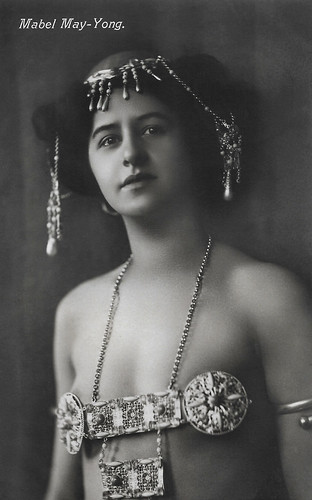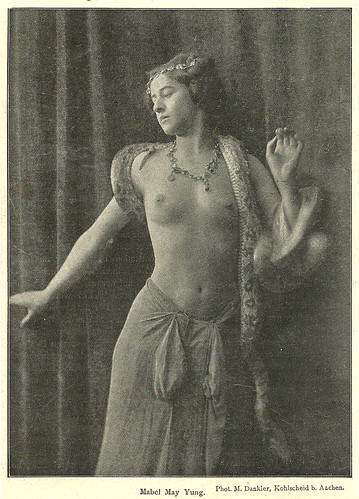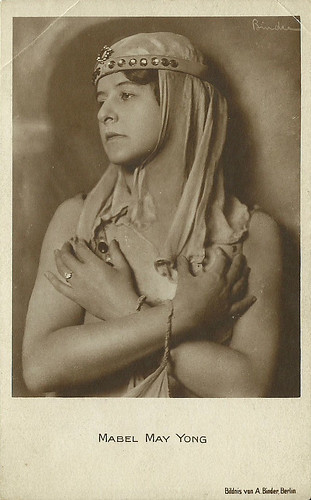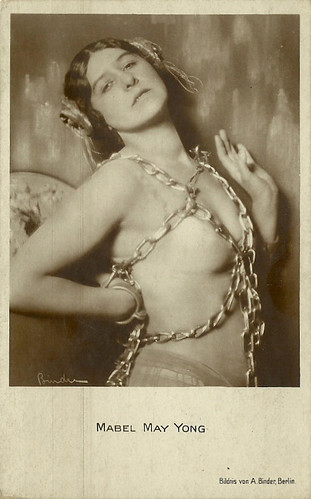
German postcard.

Photo: M. Dankler, Kohlscheid near Aachen. Collection: Didier Hanson.
Salome
Postcard collector Didier Hanson once sent us scans of postcards of Mabel May-Yong and immediately we were fascinated. Who was this creature and where did she come from?
You can find other pictures on the net that suggest she was a belly dancer. She appeared in these pictures in exotic and quite revealing costumes, like Salome or Mata Hari. According to IMDb, she was born as Mabel May Trezise in 1883 in Moonta, Australia. She married George Hamilton Young in 1902 and had 7 children.
Credited as Mabel May, she (probably) made her film debut in a South African production (!), the adventure film Allan Quatermain (H. Lisle Lucoque, 1919) featuring Hal Lawrence. In this early silent film version of H. Rider Haggard’s legendary novel 'King Solomon’s Mines', she played Queen Nylephtha. H. Rider Haggard was present for a private screening on All Hallow's Even in 1919 and wrote of it in his diary: "It is not at all bad, but it might be a great deal better." No print is known to survive but stills of the film are preserved in a South African film archive.
However, according to IMDb, the “Mabel May” who plays in Allan Quatermain was an English-born actress (1892-1957) who starred in South-African films from 1916 to 1921. She married I.W. Schlesinger, who was the founder of the African Film Productions company , which produced, among others, Allan Quatermain. So, it seems that the lady who plays Queen Nyleptha in Allan Quatermain is not Mabel May Yong.
According to other sources, Dietrich Schult at The Cabinet Card Gallery and Wikipedia, she was born in 1884 in Magdeburg/Elbe as Alice Mabel Auguste Scharrer. Her father was the businessman Max Scharrer, and her mother was either Chinese or Vietnamese, Elizabeth Ann "Lizzie" Hoa-Mai.
May-Yong married in Magdeburg, purportedly into the Schenck zu Schweinsberg noble family. In October 1914, months after the onset of World War I, she arrived in New York from Rotterdam on the ship Rotterdam, as Baroness Alice Schenk zu Schweinsberg, married and living in Berlin, but listing her father, Max Scharrer, living in Magdeburg, as her closest relative.
The New York Times of 28 October 1914, reported the arrival at the Astor Theatre of "Baroness Alice Mabel von Schenck zu Schweinsberg, who danced in Germany under the name of Mabel May Yong". She performed at Astor and at the Victoria Theatre and returned to Germany in January 1915.
Mabel May-Yong soon moved to the metropolis of the European film industry at that time, Berlin.

German postcard. Photo: Alex Binder. Collection: Didier Hanson.
Vampire
As May de Yong, she appeared in two German silent films, Um die Liebe des Dompteurs/For the love of the trainer (Karl Heiland, 1918) about a drama in circus Sarasani, and Der Diplomatensäugling/The diplomat's infant (Erich Schönfelder, 1919) starring Paul Heidemann. If she made these films before or after the South African production is unclear.
In 1920 Mabel May-Yong played in ten (yes, 10!) German films and in 1921 in another seven, according to Filmportal.de. According to IMDb, she made a still impressive 8 films in 1920 and 7 films in 1921.
Among these productions were Indische Rache/Indian Revenge (Georg Jacoby, Leo Lasko, 1920) with Harry Liedtke, the crime film Das schwarze Boot/The Black Boat (Max Neye, 1920) with Ludwig Trautmann, Fasching/Carnival (Frederic Zelnik, 1921) starring Lya Mara, and Das Haus der Qualen/The house of the tortures (Carl Wilhelm, 1921) with Fritz Kortner.
In these films, she often played Russian or Oriental women as a German Theda Bara. In Die goldene Mauer/The Golden Wall (Siegfried Dessauer, 1921) she co-starred again with Ludwig Trautmann, one of Germany’s first real film stars, who's now sadly forgotten.
She also had the lead in the vampire film Was der Totenkopf erzählt/What the skull tells (Bruno Eichgrün, 1921) opposite Fritz Kampers. The following year she played parts in four films, including another exotic character called Pula Sibierska in the Nick Carter detective film Frauen, die die Ehe brechen/Women Who Break Marriages (Bruno Eichgrün, 1922).
After these three busy years, her star quickly faded. In 1923 she made only one more film, Das Kabinett des Dr. Segato/The Cabinet of Dr. Segato (?, 1923) with Theodor Loos, and two years later she had her last film appearance in Entsiegelte Lippen/Unsealed lips (Bruno Eichgrün, 1925) again with Fritz Kampers.
During her brief film career, Mabel May-Yong appeared in 24 films. According to IMDb, Mabel May Yong died in 1945 at the age of 62.

German postcard. Photo: Alex Binder. Collection: Didier Hanson.

Ludwig Trautmann. German postcard by Photochemie, no. K. 1594. Photo: Alex Binder, Berlin.
Sources: Jessica Amanda Salmonson (The H. Rider Haggard Filmography), Stephanie D'heil (Steffi-line - German), Filmportal.de, The Cabinet Card Gallery, Wikipedia and IMDb. Additional info supplied by Marlene Pilaete.
This post was last updated on 7 June 2022.
No comments:
Post a Comment